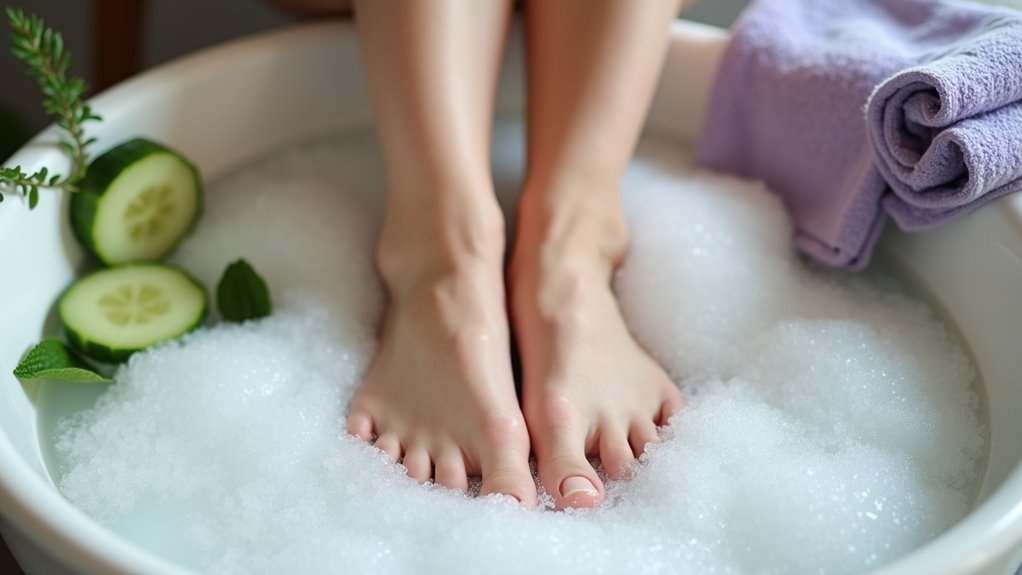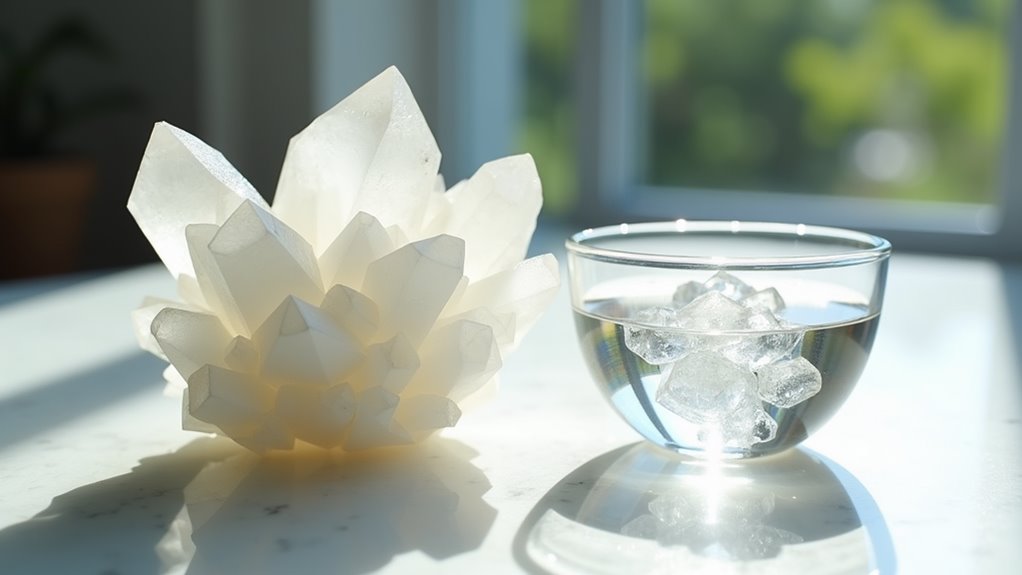How to Cure Swollen Feet Overnight!
To reduce swollen feet overnight, elevate them above your heart level for 15-20 minutes before bed using pillows. Take a warm Epsom salt foot bath, then gently massage your feet with peppermint oil mixed in a carrier oil. Perform simple ankle rotations and toe stretches before resting. Stay hydrated but avoid excess salt intake. While these steps help provide quick relief, understanding the underlying causes can lead to more effective long-term solutions.
Understanding the Common Causes of Foot Swelling
There are three main reasons why your feet might swell: medical conditions, lifestyle factors, and environmental causes.
When you’re experiencing swollen feet, it’s essential to identify what’s triggering the swelling before trying swollen feet remedies.
Medical conditions like heart disease, kidney problems, or pregnancy commonly cause fluid retention in your feet. If you’re dealing with these issues, you’re not alone – many people face similar challenges.
Lifestyle factors such as prolonged sitting, standing, or a high-sodium diet can also lead to swelling. You’ll often notice this after long flights or desk-bound workdays.
Environmental factors, particularly hot weather, can make your feet swell as your body tries to cool down. Staying hydrated is crucial in managing swelling and can help reduce discomfort.
Before pursuing any treatment, it’s smart to understand which category your swelling falls into. This knowledge will help you choose the most effective remedies and know when you should consult a healthcare provider.
Immediate Relief Through Elevation and Rest
A simple yet effective way to reduce foot swelling is elevating your feet above heart level while resting.
You’ll want to prop your feet on pillows while lying down, aiming for about 12 inches above your heart. This position helps fluid drain away from your feet and back toward your core.
For the best results, you should maintain this elevated position for at least 15-20 minutes, three to four times daily. Many people find it helpful to do this during their regular breaks or while watching TV. During these rest periods, you can gently rotate your ankles and wiggle your toes to promote circulation. Additionally, incorporating regular foot elevation into your daily routines promotes self-care.
Natural Remedies and Herbal Solutions
Several natural remedies and herbs can effectively reduce foot swelling without medication.
You’ll find that Epsom salt baths provide quick relief, as the magnesium sulfate helps draw out excess fluid while reducing inflammation. Try soaking your feet for 15-20 minutes in warm water with a half cup of Epsom salt.
Ginger tea is another powerful solution you can easily prepare at home. Just steep fresh ginger slices in hot water, as this herb’s natural anti-inflammatory properties help improve circulation.
You might also want to try massage with peppermint oil, which creates a cooling sensation while stimulating blood flow. For best results, mix a few drops with a carrier oil like coconut oil.
Don’t forget about parsley tea, a natural diuretic that many people in your situation find helpful. Simply steep fresh parsley in hot water for 5 minutes and drink twice daily to reduce fluid retention. Additionally, it is important to stay hydrated to help flush out excess salt and prevent swelling.
Essential Stretches and Exercises
While natural remedies help reduce swelling, physical movement plays a key role in improving circulation and reducing fluid buildup in your feet.
You’ll want to start with gentle ankle rotations, moving your feet in circular motions both clockwise and counterclockwise for about 30 seconds each direction.
Next, try toe stretches by pointing and flexing your toes repeatedly. This simple exercise helps pump excess fluid back up your legs.
Another effective movement is the heel-to-toe walk – just like you’re walking on an imaginary tightrope. Do this for about 5 minutes.
Don’t forget calf raises: Stand near a wall for support, rise up on your toes, hold for 3 seconds, then lower back down. Repeat 15 times.
Finally, lie on your back with your legs up against a wall for 5-10 minutes. This position naturally helps drain fluid from your feet and reduces swelling. Engaging in regular physical activity can also improve poor circulation, which is a common cause of swollen feet.
Dietary Changes to Reduce Fluid Retention
Making smart food choices can significantly impact fluid retention in your feet. You’ll want to reduce your sodium intake since excess salt causes your body to hold onto water. Instead, focus on potassium-rich foods like bananas, sweet potatoes, and leafy greens, which help balance fluid levels.
Add natural diuretic foods to your daily menu, including cucumber, celery, and watermelon. These foods will help your body flush out excess fluids naturally. Additionally, incorporating compression socks can further assist in reducing swelling by improving circulation.
Don’t forget to incorporate foods high in magnesium, such as nuts, seeds, and whole grains, as they help regulate water balance in your cells.
While adjusting your diet, it’s crucial to stay well-hydrated. Though it might seem counterintuitive, drinking plenty of water actually helps reduce swelling. Aim for eight glasses daily, and limit alcohol and caffeine, which can contribute to dehydration and make swelling worse.
When to Seek Professional Medical Help
Although most cases of swollen feet can be managed at home, you should contact your doctor immediately if you notice sudden or severe swelling, especially if it’s only in one leg. This could indicate a serious condition like deep vein thrombosis (DVT) or a blood clot that requires urgent medical attention.
Don’t hesitate to seek professional help if you’re experiencing persistent swelling accompanied by chest pain, difficulty breathing, or fever. These symptoms might signal heart, kidney, or liver problems that many others have faced and overcome with proper medical care. Additionally, consider that staying hydrated can play a crucial role in reducing swelling and improving overall well-being.
You’ll also want to consult your healthcare provider if you notice skin changes like redness, warmth, or tenderness around the swollen area.
If you’re pregnant and develop sudden swelling in your feet, hands, or face, it’s essential to get checked, as this could be a sign of preeclampsia – a condition that many expectant mothers have successfully managed with timely medical intervention.
Frequently Asked Questions
Can Wearing Compression Socks While Sleeping Help Reduce Foot Swelling?
You shouldn’t wear compression socks while sleeping as they can restrict circulation during rest. Instead, elevate your feet above heart level and use regular cotton socks if needed.
Is Foot Swelling During Pregnancy Dangerous for the Baby?
While foot swelling during pregnancy is common, you’ll want to contact your doctor if it’s severe or sudden, as it could indicate preeclampsia, which can affect you and your baby.
Do Certain Shoe Materials Worsen or Improve Swollen Feet?
You’ll find breathable materials like mesh and canvas help reduce swelling, while tight synthetic materials make it worse. Look for flexible, natural fabrics that won’t constrict your feet’s movement.
How Long Should Compression Stockings Be Worn During the Day?
You’ll want to wear your compression stockings from the moment you wake up until bedtime. Don’t worry – most people like you need full-day wear for the best results.
Can Swollen Feet Affect Shoe Size Permanently?
If you’re dealing with chronic swelling, your feet can temporarily need larger shoes, but once you’ve treated the underlying cause, your regular shoe size should return to normal.





